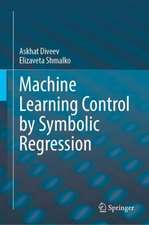Data Science, Analytics and Machine Learning with R
Autor Luiz Paulo Favero, Patricia Belfiore, Rafael de Freitas Souzaen Limba Engleză Paperback – 24 ian 2023
In addition, an entire chapter focuses on the concept of spatial analysis, allowing readers to build their own maps through geo-referenced data (such as in epidemiologic research) and some basic statistical techniques. Other chapters cover ensemble and uplift modeling and GLMM (Generalized Linear Mixed Models) estimations, both linear and nonlinear.
- Presents a comprehensive and practical overview of machine learning, data mining and AI techniques for a broad multidisciplinary audience
- Serves readers who are interested in statistics, analytics and modeling, and those who wish to deepen their knowledge in programming through the use of R
- Teaches readers how to apply machine learning techniques to a wide range of data and subject areas
- Presents data in a graphically appealing way, promoting greater information transparency and interactive learning
Preț: 756.34 lei
Preț vechi: 945.42 lei
-20% Nou
Puncte Express: 1135
Preț estimativ în valută:
144.73€ • 151.80$ • 120.48£
144.73€ • 151.80$ • 120.48£
Carte disponibilă
Livrare economică 11-25 martie
Livrare express 25 februarie-01 martie pentru 70.56 lei
Preluare comenzi: 021 569.72.76
Specificații
ISBN-13: 9780128242711
ISBN-10: 012824271X
Pagini: 660
Ilustrații: 400 illustrations (200 in full color)
Dimensiuni: 216 x 276 x 35 mm
Greutate: 1.51 kg
Editura: ELSEVIER SCIENCE
ISBN-10: 012824271X
Pagini: 660
Ilustrații: 400 illustrations (200 in full color)
Dimensiuni: 216 x 276 x 35 mm
Greutate: 1.51 kg
Editura: ELSEVIER SCIENCE
Public țintă
Data science and data engineering professionals, as well as researchers and engineers who need to ensure consistent, accurate and reliable data across their company, lab, hospital, etc.Graduate students in data science, compute science, and big data
Cuprins
Part I: Introduction
1. Overview of Data Science, Analytics, and Machine Learning
2. Introduction to the R Language
Part II: Applied Statistics and Data Visualization
3. Variables and Measurement Scales
4. Descriptive and Probabilistic Statistics
5. Hypotheses Tests
6. Data Visualization and Multivariate Graphs
Part III: Data Mining and Preparation
7. Building Handcrafted Robots
8. Using APIs to Collect Data
9. Managing Data
Part IV: Unsupervised Machine Learning Techniques
10. Cluster Analysis
11. Factorial and Principal Component Analysis (PCA)
12. Association Rules and Correspondence Analysis
Part V: Supervised Machine Learning Techniques
13. Simple and Multiple Regression Analysis
14. Binary, Ordinal and Multinomial Regression Analysis
15. Count-Data and Zero-Inflated Regression Analysis
16. Generalized Linear Mixed Models
Part VI: Improving Performance and Introduction to Deep Learning
17. Support Vector Machine
18. CART (Classification and Regression Trees)
19. Bagging, Boosting and Uplift (Persuasion) Modeling
20. Random Forest
21. Artificial Neural Network
22. Introduction to Deep Learning
Part VII: Spatial Analysis
23. Working on Shapefiles
24. Dealing with Simple Features Objects
25. Raster Objects
26. Exploratory Spatial Analysis
Part VII: Adding Value to your Work
27. Enhanced and Interactive Graphs
28. Dashboards with R
1. Overview of Data Science, Analytics, and Machine Learning
2. Introduction to the R Language
Part II: Applied Statistics and Data Visualization
3. Variables and Measurement Scales
4. Descriptive and Probabilistic Statistics
5. Hypotheses Tests
6. Data Visualization and Multivariate Graphs
Part III: Data Mining and Preparation
7. Building Handcrafted Robots
8. Using APIs to Collect Data
9. Managing Data
Part IV: Unsupervised Machine Learning Techniques
10. Cluster Analysis
11. Factorial and Principal Component Analysis (PCA)
12. Association Rules and Correspondence Analysis
Part V: Supervised Machine Learning Techniques
13. Simple and Multiple Regression Analysis
14. Binary, Ordinal and Multinomial Regression Analysis
15. Count-Data and Zero-Inflated Regression Analysis
16. Generalized Linear Mixed Models
Part VI: Improving Performance and Introduction to Deep Learning
17. Support Vector Machine
18. CART (Classification and Regression Trees)
19. Bagging, Boosting and Uplift (Persuasion) Modeling
20. Random Forest
21. Artificial Neural Network
22. Introduction to Deep Learning
Part VII: Spatial Analysis
23. Working on Shapefiles
24. Dealing with Simple Features Objects
25. Raster Objects
26. Exploratory Spatial Analysis
Part VII: Adding Value to your Work
27. Enhanced and Interactive Graphs
28. Dashboards with R




























